 |
Burial, Ritual, Religion, and Cannibalism |
 |
 |
Burial, Ritual, Religion, and Cannibalism |
 |
![]() In the same humanly manner that
Neandertals cared for their disabled companions, they also buried their dead.
"Neanderthals were not credited with deliberate meaningful burial of their dead
until more than a half-century after their discovery" (Constable 1965:97). This
"betrays a keen self-awareness and a concern for the human spirit" (Leaky and
Lewin 1977:125). Their grave sites were intentional, and many have been found in
different areas in Europe and the Near East. Neandertal interments have
humanistic and ritualistic elements, with the cadaver placed in a sleeping or
fetal position, with the head facing west and the feet pointing east. A few
remains have been found with fauna placed in the hands or the body, along with
red ocher, a colored pigment possibly used for symbolic ritual. Some Neandertals
were buried together, meaning that entire kin groups remained united after
death.
In the same humanly manner that
Neandertals cared for their disabled companions, they also buried their dead.
"Neanderthals were not credited with deliberate meaningful burial of their dead
until more than a half-century after their discovery" (Constable 1965:97). This
"betrays a keen self-awareness and a concern for the human spirit" (Leaky and
Lewin 1977:125). Their grave sites were intentional, and many have been found in
different areas in Europe and the Near East. Neandertal interments have
humanistic and ritualistic elements, with the cadaver placed in a sleeping or
fetal position, with the head facing west and the feet pointing east. A few
remains have been found with fauna placed in the hands or the body, along with
red ocher, a colored pigment possibly used for symbolic ritual. Some Neandertals
were buried together, meaning that entire kin groups remained united after
death.
![]() One of the most fascinating and
controversial
One of the most fascinating and
controversial 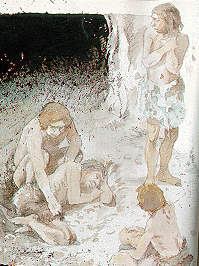 burial sites is the Shanidar Cave. The remains there, called
Shanidar IV, were carefully placed in the fetal position on a rough bedding of
woven woody horsetail, a type of local plant. According to the pollen samples
taken, this Neandertal was interred with several different species of flowers.
"From the orderly distribution of grains around the fossil remains, there is no
question that the flowers were arranged deliberately and did not simply topple
into the grave, as believed, as the body was being covered" (Leaky and Lewin
1977:125). Apparently, the family and friends of the deceased gathered these
distinct species of flowers, carried them to the grave, and carefully placed
them on the body. Some of the
burial sites is the Shanidar Cave. The remains there, called
Shanidar IV, were carefully placed in the fetal position on a rough bedding of
woven woody horsetail, a type of local plant. According to the pollen samples
taken, this Neandertal was interred with several different species of flowers.
"From the orderly distribution of grains around the fossil remains, there is no
question that the flowers were arranged deliberately and did not simply topple
into the grave, as believed, as the body was being covered" (Leaky and Lewin
1977:125). Apparently, the family and friends of the deceased gathered these
distinct species of flowers, carried them to the grave, and carefully placed
them on the body. Some of the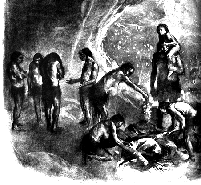 flower specimens found with Shanidar IV were yarrow,
cornflowers, St. Banaby's thistle, groundsel, grape hyacinths, woody horsetail,
and a kind of mallow. Many of these have medicinal qualities which "range from
relief from toothache and inflammation to uses as poultices and for spasm"
(Solecki 1971:249). According to Solecki, "one may speculate that the individual
was not only a very important man, a leader, but may have been a kind of
medicine man or shaman in his group" (Shreeve 1995:53). From this analysis it is
likely that the "Shanidar people were aware of at least some of the medicinal
properties of the flowers is not unlikely" (Leaky and Lewin
1977:125).
flower specimens found with Shanidar IV were yarrow,
cornflowers, St. Banaby's thistle, groundsel, grape hyacinths, woody horsetail,
and a kind of mallow. Many of these have medicinal qualities which "range from
relief from toothache and inflammation to uses as poultices and for spasm"
(Solecki 1971:249). According to Solecki, "one may speculate that the individual
was not only a very important man, a leader, but may have been a kind of
medicine man or shaman in his group" (Shreeve 1995:53). From this analysis it is
likely that the "Shanidar people were aware of at least some of the medicinal
properties of the flowers is not unlikely" (Leaky and Lewin
1977:125).
![]() Seven individual Neandertal graves were found at La
Ferrassie, in the southwest region of France. These consisted of a man, a woman,
two children, and three infants. The man was aged about forty-five
and:
Seven individual Neandertal graves were found at La
Ferrassie, in the southwest region of France. These consisted of a man, a woman,
two children, and three infants. The man was aged about forty-five
and:
his skeleton showedthat he had been buried lying on his back, slightly inclined towards the left, with flexed legs. Three flat stones, were associated with the burial, one near the skull and the others on the arms, and various incised large bones, bone splinters, and flint flakes had been put in his grave, the former often being interpreted as protection for the burial. Near the male grave was the skeleton of a woman aged between twenty-five and thirty, buried in a such a position to suggest that she might have been tied up before burial. No grave goods accompanied this burial. Neandertals three and four were buried in trenches both 30-40 cm deep and very similar in appearance. They contained the bones of two (possibly three) children and one fetus or neonate. Amidst the sterile trenches was one oval depression, 40 by 30 cm, which contained the remains of an incomplete foetus (aged about seven months) and three beautifully-made racloirs. (Shackley 1980:87)
of vital importance in the growth of ideas about Neandertals during the turn of this century. This individual was buried on his back, with his head to the west, the left arm extended and his legs flexed to the right. Next to the head were three long bones of a mammalian metatarsal, along with other animal remains. Many of these bones appear to have be burnt, as well as the surrounding sediment, which could possibly represent some feast that took place before this individual was buried. |
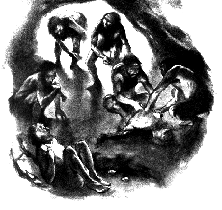 |
![]() Another Neandertal burial site, that of a
post-adolescent male, was found in Le Moustier, in southern France. The remains
had been sprinkled with red ocher and buried in a position simulating being
asleep. "His head rested on a pillow of flints, and burned wild cattle bones
were scattered about, as if in offering" (Shreeve 1995:53). At the Teshik-Tash
site in Uzbekistan, a child of about nine years of age was buried with mountain
goat horns surrounding his grave. They had been arranged vertically, in pairs,
forming a circle around the body, with the pointed ends driven in the ground
(Shackley 1980). Below the cranium was a small block of limestone which seemed
to be inserted in order to support the material on which the head
rested.
Another Neandertal burial site, that of a
post-adolescent male, was found in Le Moustier, in southern France. The remains
had been sprinkled with red ocher and buried in a position simulating being
asleep. "His head rested on a pillow of flints, and burned wild cattle bones
were scattered about, as if in offering" (Shreeve 1995:53). At the Teshik-Tash
site in Uzbekistan, a child of about nine years of age was buried with mountain
goat horns surrounding his grave. They had been arranged vertically, in pairs,
forming a circle around the body, with the pointed ends driven in the ground
(Shackley 1980). Below the cranium was a small block of limestone which seemed
to be inserted in order to support the material on which the head
rested.
![]() In addition to interring their dead, it is believed
that Neandertals also performed burial rituals. Evidence pointing to this is
that many existing Neandertal burials, including the ones just mentioned,
contain tools and food offerings. Several of these sites also have hearths
around the skeletons. "This might represent a ritual element, such as the
provision of warmth to counteract the chill of death, but it is more likely to
be the remains of a funeral feast fire, lit while the 'last rites' were being
carried out" (Shackley 1980:104). Burials that include these hearths are the
previously mentioned La-Chappelle-aux-Saints grave, which contained supposedly
burned animal bones surrounding the body. When this site was originally
excavated, it was concluded that it "had been a sepulchre where people came to
eat (numerous) funeral meals but not to live, since the cave was too low arched
for comfortable living, and there was no waste from tool manufacture" (Shackley
1980:103).
In addition to interring their dead, it is believed
that Neandertals also performed burial rituals. Evidence pointing to this is
that many existing Neandertal burials, including the ones just mentioned,
contain tools and food offerings. Several of these sites also have hearths
around the skeletons. "This might represent a ritual element, such as the
provision of warmth to counteract the chill of death, but it is more likely to
be the remains of a funeral feast fire, lit while the 'last rites' were being
carried out" (Shackley 1980:104). Burials that include these hearths are the
previously mentioned La-Chappelle-aux-Saints grave, which contained supposedly
burned animal bones surrounding the body. When this site was originally
excavated, it was concluded that it "had been a sepulchre where people came to
eat (numerous) funeral meals but not to live, since the cave was too low arched
for comfortable living, and there was no waste from tool manufacture" (Shackley
1980:103).
]![]() Another interment which contains ritual implications is
the burial at Teshik-Tash. As previously mentioned, the horns driven in the
ground around the body were probably placed there for symbolic protection.
However, a small hearth had been made next to the horns, which burnt for a short
amount of time, according to the evidence of the underlying clay not redding
(Shackley 1980). These associations also make it probable that some form of a
funerary ritual was performed (Shackley 1980).
Another interment which contains ritual implications is
the burial at Teshik-Tash. As previously mentioned, the horns driven in the
ground around the body were probably placed there for symbolic protection.
However, a small hearth had been made next to the horns, which burnt for a short
amount of time, according to the evidence of the underlying clay not redding
(Shackley 1980). These associations also make it probable that some form of a
funerary ritual was performed (Shackley 1980).
![]() Other burial ritual behavior occurred in Le
Moustier, where a young man's body was posthumously sprinkled with red ocher. At
La Ferrassie, the buried man and woman were found head to head, in the front of
the cave, and the children were interred further back towards the center. At
this site, there were also nine mysterious mounds, all the same size and height,
arranged in rows of three. Within one of these mounds rested the neonate and
three beautiful flints. "The original investigators concluded that the mounds
were built in an interment ritual" (Benditt 1989:33). However, anthropologists
are still baffled by their significance.
Other burial ritual behavior occurred in Le
Moustier, where a young man's body was posthumously sprinkled with red ocher. At
La Ferrassie, the buried man and woman were found head to head, in the front of
the cave, and the children were interred further back towards the center. At
this site, there were also nine mysterious mounds, all the same size and height,
arranged in rows of three. Within one of these mounds rested the neonate and
three beautiful flints. "The original investigators concluded that the mounds
were built in an interment ritual" (Benditt 1989:33). However, anthropologists
are still baffled by their significance.
![]() Some ritual or symbolic purpose may be found in the
stone slabs found over Neandertal graves, along with food, tools, and the flexed
position of the body. F. Clark Howell believes that:
Some ritual or symbolic purpose may be found in the
stone slabs found over Neandertal graves, along with food, tools, and the flexed
position of the body. F. Clark Howell believes that:
Evidence of this source clearly indicates that Neanderthal man believed in life after death and that it was probably not unlike the life he lived on earth, sine he seemed to be trying to help his corpses along on their journeys with tools and food. Death itself appears to have been regarded as a kind of sleep, since corpses were carefully arranged in sleeplike positions. (Howell 1965:130)
![]() Robert H. Gargett, as a graduate student at the
University of California at Berkeley, believed that all the known Neandertal
burials can be accounted for by natural preservational processes. Gargett
hypothesized that the differential conservation of their remains may be due to
geology and not human compassion (Benditt 1989). The most complete Neandertal
skeletons were found in caves, where, he indicates, interment can be mimicked by
the forces of nature. For example, at La-Chapelle-aux-Saints, the grave of the
"Old Man" could have been caused by the dissolving action of water on the
limestone floor of the cave. Gargett then claims that if the elderly Neanderthal
had crawled into the small cave and died, "the natural disposition of sediments
would have left something resembling a grave" (Benditt 1989:32). Gargett also
stated that the nine mounds at La Ferrassie could have also been created by
natural forces. He suggests that they may have been made "due to the action of
frost, which can create geometrically patterned hummocks" (Benditt 1989:32).
Therefore, Gargett is very skeptical of most Neandertal burials.
Robert H. Gargett, as a graduate student at the
University of California at Berkeley, believed that all the known Neandertal
burials can be accounted for by natural preservational processes. Gargett
hypothesized that the differential conservation of their remains may be due to
geology and not human compassion (Benditt 1989). The most complete Neandertal
skeletons were found in caves, where, he indicates, interment can be mimicked by
the forces of nature. For example, at La-Chapelle-aux-Saints, the grave of the
"Old Man" could have been caused by the dissolving action of water on the
limestone floor of the cave. Gargett then claims that if the elderly Neanderthal
had crawled into the small cave and died, "the natural disposition of sediments
would have left something resembling a grave" (Benditt 1989:32). Gargett also
stated that the nine mounds at La Ferrassie could have also been created by
natural forces. He suggests that they may have been made "due to the action of
frost, which can create geometrically patterned hummocks" (Benditt 1989:32).
Therefore, Gargett is very skeptical of most Neandertal burials.
![]() In contrast, anthropologists Philip Chase and
Harold Dibble believe that "deliberate burials are clearly present, but there
are no obvious signs of ritual" (Chase and Dibble 1987:276). According to both
authors, Middle Paleolithic graves only contain items of everyday use, causing
one to question whether they reflect any symbolic or ritual ceremony before
interment. Most burials are located in the occupational areas of the sites and
objects relevant to these interments are indistinguishable from the artifacts
found throughout the entire area. An example of this is the Teshik-Tash site.
Even though it appears that the young Neandertal's grave was surrounded by a
ring of Siberian mountain goat horns, these specimens were found throughout the
site, making up a vast majority of the faunal remains. Chase and Dibble conclude
that:
In contrast, anthropologists Philip Chase and
Harold Dibble believe that "deliberate burials are clearly present, but there
are no obvious signs of ritual" (Chase and Dibble 1987:276). According to both
authors, Middle Paleolithic graves only contain items of everyday use, causing
one to question whether they reflect any symbolic or ritual ceremony before
interment. Most burials are located in the occupational areas of the sites and
objects relevant to these interments are indistinguishable from the artifacts
found throughout the entire area. An example of this is the Teshik-Tash site.
Even though it appears that the young Neandertal's grave was surrounded by a
ring of Siberian mountain goat horns, these specimens were found throughout the
site, making up a vast majority of the faunal remains. Chase and Dibble conclude
that:
We might, therefore, expect some association with the burial simply due to random dispersal of remains of that species through the site. But such association would not have significant behavioral implications. Second, the association between the goat horn cores and the burial is not that strong. At the time of the discovery only the skull lay within the concentration of horn cores and the postcranial remains lay beyond it. The dispersal of the bones suggest predator disturbance....Even if the horn cores were at one time associated with the burials, the association may have been pragmatic rather than ritual: the horns may simply have been used as picks for excavating the grave. (Chase and Dibble 1987:276).Therefore, in order for Neandertal graves to be truly symbolic or ritualistic of "religion or belief in an afterlife, the grave goods must exhibit some special characters beyond those seen in other contexts of the site," such as those in Upper Paleolithic burials (Chase and Dibble 1987:274).
![]() Another ritually symbolic behavior that Neandertals
are believed
Another ritually symbolic behavior that Neandertals
are believed 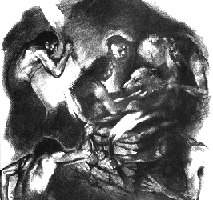 to have practiced is the worship of cave bears. Collections of bear
bones at several widely dispersed sites suggest this, especially at Drachenlock,
in Switzerland, where "a number of bear skulls were found stacked in a stone
chest" (Kennedy 1975:92). The stone chest was believed to have been built by the
Neandertals, who also inhabited the entrance of the cave. The top of the
structure was covered by a massive stone slab. "Inside this were the skulls of
seven bears arranged with their muzzles facing the cave entrance, and still
deeper in the cave a further six bear skulls in niches along the wall" (Shackley
1980:110). Next to these remains, were bundles of limb bones belonging to
different bears. Consequently, it was at this site that the supposed symbol of
the "Cult of the Cave Bear" was found. This consisted of the skull of a
three-year-old bear pierced in the cheek by the leg-bone of younger bear. "These
are resting on two bones from still two other bears, an arrangement that could
hardly have happened by chance"(Howell 1965:127).
to have practiced is the worship of cave bears. Collections of bear
bones at several widely dispersed sites suggest this, especially at Drachenlock,
in Switzerland, where "a number of bear skulls were found stacked in a stone
chest" (Kennedy 1975:92). The stone chest was believed to have been built by the
Neandertals, who also inhabited the entrance of the cave. The top of the
structure was covered by a massive stone slab. "Inside this were the skulls of
seven bears arranged with their muzzles facing the cave entrance, and still
deeper in the cave a further six bear skulls in niches along the wall" (Shackley
1980:110). Next to these remains, were bundles of limb bones belonging to
different bears. Consequently, it was at this site that the supposed symbol of
the "Cult of the Cave Bear" was found. This consisted of the skull of a
three-year-old bear pierced in the cheek by the leg-bone of younger bear. "These
are resting on two bones from still two other bears, an arrangement that could
hardly have happened by chance"(Howell 1965:127).
![]() In Regourdou, southern France, a similar phenomenon
was encountered. Here, a rectangular pit contained the remains, most of which
were skulls, of at least twenty bears, covered by a massive stone slab weighing
nearly a ton . Nearby, lay the remains of a Neandertal in another stone pit,
with various objects, including a bear humerus, a scraper, a core, and some
flakes, which were interpreted as grave offerings (Chase and Dibble
1987).
In Regourdou, southern France, a similar phenomenon
was encountered. Here, a rectangular pit contained the remains, most of which
were skulls, of at least twenty bears, covered by a massive stone slab weighing
nearly a ton . Nearby, lay the remains of a Neandertal in another stone pit,
with various objects, including a bear humerus, a scraper, a core, and some
flakes, which were interpreted as grave offerings (Chase and Dibble
1987).
![]() Perhaps related to cave bear worship, is the
unusual finding in a deep chamber of Basua Cave in Savona, Italy, where a
vaguely zoomorphic stalagmite, surrounded by clay pellets, was apparently used
by Neandertals for a ceremony. Bear bones lay scattered on the floor, which
further suggests that this was unlikely to be just a game, and must have had
some sort of ritual purpose (Kennedy 1975).
Perhaps related to cave bear worship, is the
unusual finding in a deep chamber of Basua Cave in Savona, Italy, where a
vaguely zoomorphic stalagmite, surrounded by clay pellets, was apparently used
by Neandertals for a ceremony. Bear bones lay scattered on the floor, which
further suggests that this was unlikely to be just a game, and must have had
some sort of ritual purpose (Kennedy 1975).
![]() In contrast to the idea that Neandertals built
these cave bear storage pits for ritual purposes, it is possible that these
sites can be explained by natural agencies (Chase and Dibble 1987). Underground
streams could have caused an accumulation of cave bear bones in natural niches,
and groups of fallen roof blocks. Another attribute is that cave bears prepared
circular nests and sometimes died during hibernation. Cave ins may explain the
creation of pits with large tops covering them. It is possible that some bears
died of natural causes in these caves and over a period of time, as cave ins
occurred, the effect of a storage pit was created. Chase and Dibble also
discovered faulty interpretations produced during the early twentieth century in
the examination of caves that containing alleged cave bear cults. Early
archaeologists poorly recorded data on possible hunting wounds on the bears or
evidence to indicate if they had been butchered (Chase and Dibble
1987).
In contrast to the idea that Neandertals built
these cave bear storage pits for ritual purposes, it is possible that these
sites can be explained by natural agencies (Chase and Dibble 1987). Underground
streams could have caused an accumulation of cave bear bones in natural niches,
and groups of fallen roof blocks. Another attribute is that cave bears prepared
circular nests and sometimes died during hibernation. Cave ins may explain the
creation of pits with large tops covering them. It is possible that some bears
died of natural causes in these caves and over a period of time, as cave ins
occurred, the effect of a storage pit was created. Chase and Dibble also
discovered faulty interpretations produced during the early twentieth century in
the examination of caves that containing alleged cave bear cults. Early
archaeologists poorly recorded data on possible hunting wounds on the bears or
evidence to indicate if they had been butchered (Chase and Dibble
1987).
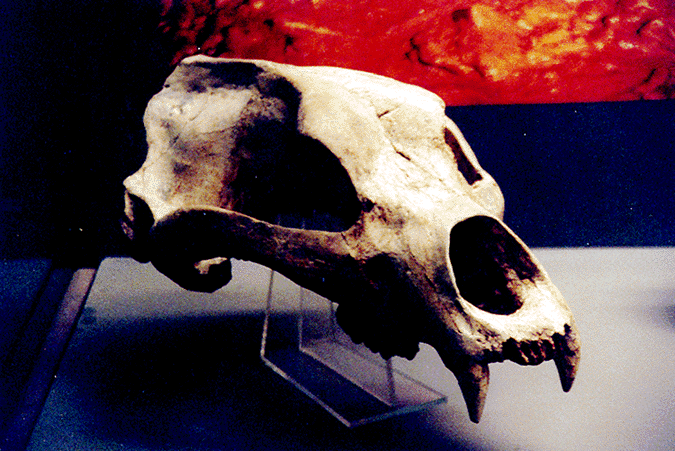 |
| A cave bear skull |
![]() Neandertal man may have practiced cannibalism, due
to hunger, or as some form of death ritual. One of the most controversial sites
dealing with this issue is in Monte Circeo, Italy, where in 1939, a Neandertal
skull was discovered in an oval ring of stones. The hole where the spine
connects to the head, known as the foramen magnum, had been enlarged and broken
away, suggesting that the brains were extracted and consumed. However, the
original position of the skull inside the ring of stones is doubtful, because
the person who discovered it, did not remember if he replaced it in its proper
position (Klein 1989). An analysis of the skull showed no cut or scrape marks,
peeling or flaking, associated with cannibalistic practices (Bower 1991).
Instead, gnaw marks consistent with carnivore chewing appear on various parts of
the skull, especially at the base. From this evidence, it is probable that a
cave hyena tampered with the skull, ate the brains, and shoved it upon an
insignificant arrangement of stones.
Neandertal man may have practiced cannibalism, due
to hunger, or as some form of death ritual. One of the most controversial sites
dealing with this issue is in Monte Circeo, Italy, where in 1939, a Neandertal
skull was discovered in an oval ring of stones. The hole where the spine
connects to the head, known as the foramen magnum, had been enlarged and broken
away, suggesting that the brains were extracted and consumed. However, the
original position of the skull inside the ring of stones is doubtful, because
the person who discovered it, did not remember if he replaced it in its proper
position (Klein 1989). An analysis of the skull showed no cut or scrape marks,
peeling or flaking, associated with cannibalistic practices (Bower 1991).
Instead, gnaw marks consistent with carnivore chewing appear on various parts of
the skull, especially at the base. From this evidence, it is probable that a
cave hyena tampered with the skull, ate the brains, and shoved it upon an
insignificant arrangement of stones.
![]() The mutilated remains of twenty Neandertal men,
women, and children were found at Krapina, Croatia, in 1899. It has been
speculated that these individuals were ritually devoured since, judging from the
great amount of animal bones in the cave, game was plentiful. Analysis done on
these remains show that "Neandertals made the same patterns of cut marks on
their fellow humans as they did on their animal prey" (Gore 1996:27). Some
scholars believe that this cannibalistic slaughter was not part of a ritual,
since all of the bones were not torn open in the same manner. Only the limb
bones, which contain an abundance of marrow, were severed. Cannibalism is
therefore seen as "one of a variety of ways Neanderthals sustained themselves
rather than an occasional act of desperation by starving humans" (Gore 1996:27).
Other evidence, such as the Teshik-Tash site and the Neander Valley skull, point
to the defleshing of the cadaver before burial. It is possible that Neandertal
man ritually ate his comrades, so that he could gain their strength and courage,
as believed by many tribes of Bushmen today. Other Neandertal death rituals may
have been involved, such as a sacrifice to a god, as in the case of the European
bog bodies.
The mutilated remains of twenty Neandertal men,
women, and children were found at Krapina, Croatia, in 1899. It has been
speculated that these individuals were ritually devoured since, judging from the
great amount of animal bones in the cave, game was plentiful. Analysis done on
these remains show that "Neandertals made the same patterns of cut marks on
their fellow humans as they did on their animal prey" (Gore 1996:27). Some
scholars believe that this cannibalistic slaughter was not part of a ritual,
since all of the bones were not torn open in the same manner. Only the limb
bones, which contain an abundance of marrow, were severed. Cannibalism is
therefore seen as "one of a variety of ways Neanderthals sustained themselves
rather than an occasional act of desperation by starving humans" (Gore 1996:27).
Other evidence, such as the Teshik-Tash site and the Neander Valley skull, point
to the defleshing of the cadaver before burial. It is possible that Neandertal
man ritually ate his comrades, so that he could gain their strength and courage,
as believed by many tribes of Bushmen today. Other Neandertal death rituals may
have been involved, such as a sacrifice to a god, as in the case of the European
bog bodies.
![]() It is yet to be proven whether or not Neandertals
truly practiced ritually symbolic behavior, or had the beginnings of a religion,
although speculation indicates it. Their dead were buried, possibly fearing
their resurrection, which might explain why many Neandertal corpses appear
tightly flexed, as if they had been tied with thongs. The placement of heavy
stone slabs upon their graves may also be seen as impeding their dead from
returning. The defleshing of the body could be symbolic of preventing its spirit
from haunting them (Constable 1973).
It is yet to be proven whether or not Neandertals
truly practiced ritually symbolic behavior, or had the beginnings of a religion,
although speculation indicates it. Their dead were buried, possibly fearing
their resurrection, which might explain why many Neandertal corpses appear
tightly flexed, as if they had been tied with thongs. The placement of heavy
stone slabs upon their graves may also be seen as impeding their dead from
returning. The defleshing of the body could be symbolic of preventing its spirit
from haunting them (Constable 1973).
![]() Neandertals
Neandertals 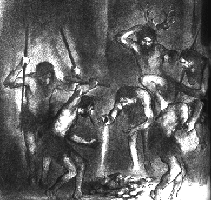 may have
practiced hunting magic and had rites related to hunting, which affected
every member of the tribe (Constable 1973). The Basua Cave contains one such
clue. Clay pellets arranged in a vague animal shape around a stalagmite, deep
within the cave, could be symbolic of a future hunt, or retelling
the story of a previous hunt. On the other hand, it could be be a child's game.
Another viable example of hunting magic was a ceremony held at a cave in
Lebanon, some fifty thousand years ago, where Neandertals dismembered a deer,
placed its remains on a bed of stones, and sprinkled it with red ocher. The
pigment was probably symbolic of blood and the act was apparently a ritualistic
or magical attempt to control life and death in the deer kingdom (Constable
1973).
may have
practiced hunting magic and had rites related to hunting, which affected
every member of the tribe (Constable 1973). The Basua Cave contains one such
clue. Clay pellets arranged in a vague animal shape around a stalagmite, deep
within the cave, could be symbolic of a future hunt, or retelling
the story of a previous hunt. On the other hand, it could be be a child's game.
Another viable example of hunting magic was a ceremony held at a cave in
Lebanon, some fifty thousand years ago, where Neandertals dismembered a deer,
placed its remains on a bed of stones, and sprinkled it with red ocher. The
pigment was probably symbolic of blood and the act was apparently a ritualistic
or magical attempt to control life and death in the deer kingdom (Constable
1973).
****NEWS FLASH*****
New evidence has come to light
that Neandertals were cannibals. Why, is still not known. The latest articles
can be found at the links below:
Evidence of Cannibalism Among Neanderthals ABC (9/30/99)
ENJOY!
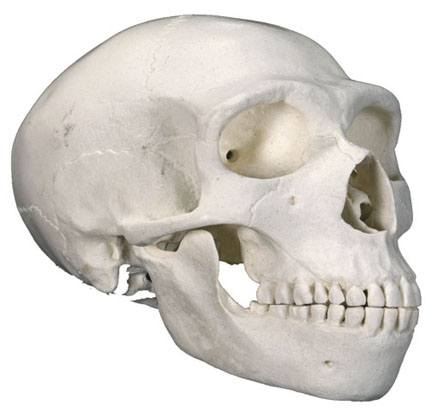 Back to Home page
index
Back to Home page
index